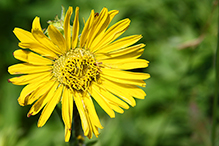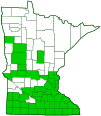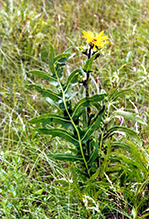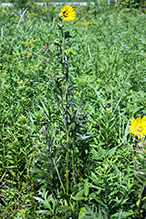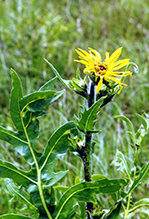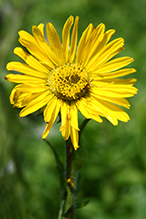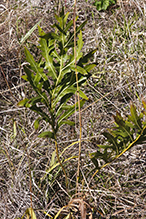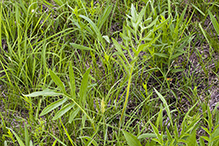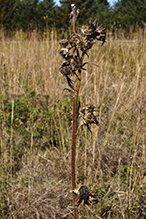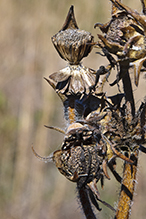compass plant
(Silphium laciniatum)
Conservation • Description • Habitat • Ecology • Use • Distribution • Taxonomy
Conservation Status |
|
|||||||
| IUCN Red List | not listed |
|||||||
| NatureServe | NNR - Unranked SNR - Unranked |
|||||||
| Minnesota | not listed |
|||||||
Description |
||
Compass plant is an erect, perennial forb that rises on usually a single stem from a deep, woody taproot that can extend 15′ into the soil. It can be 3′ to 6½′ in height, but is usually no more than 8′ tall. It is a long-lived plant, sometimes surviving up to 100 years. The stem is erect, stout, light green or medium green, round in cross section, and unbranched below the inflorescence. It is moderately covered with relatively long, white hairs and also with minute, usually gland-tipped hairs. Basal leaves are egg-shaped in outline, 12″ to 24″ long, and 6″ to 12″ wide. They are rough to the touch, thick, and leathery. They are deeply cut almost to the midrib into 3 to 15 primary lobes (pinnatifid) which are sometimes again lobed (bipinnatifid). The primary and secondary lobes are oblong to oblong triangular. They taper to a sharp point at the tip and are broadly attached at the base. The upper and lower surfaces are sparsely to moderately covered with spreading hairs and are dotted with scattered, stalkless or impressed glands. The margins are untoothed or may have a few teeth. The axis of the leaf is oriented north and south so that the blade faces east or west, thus avoiding the hot midday sun. Basal leaves are present at flowering time. Stem leaves are alternate, short-stalked or stalkless, and otherwise similar to basal leaves. They become progressively smaller as they ascend the stem. Upper stem leaves 1½″ to 6″ long, short-stalked, and once pinnatifid. The inflorescence is an elongated, usually branched cluster (panicle) of 6 to 30 flower heads at the end of the stem. The flower heads are short-stalked or nearly stalkless. The flower heads are 2½″ to 4″ in diameter. The whorl of modified leaves (bracts) at the base of the flower head (involucre) is bell-shaped to hemispheric and ⅜″ to 1 3 ⁄16″ in diameter. It is composed of 25 to 45 bracts (phyllaries) in 2 or 3 overlapping series. The phyllaries are egg-shaped, sharply pointed at the tip, ¾″ to 1 9 ⁄16″ long, and often spreading or bent backward at the tip. They are sparsely to densely hairy and are usually also dotted with glands. There are 27 to 38 ray florets and 100 to 275 disk florets. The ray florets are yellow, ¾″ to 2″ long, and fertile. The disk florets are yellow and infertile. The fruit is a dry, one-seeded seed capsule (cypsela). The cypsela is black to brown, egg-shaped, flattened, ⅜″ to 11 ⁄16″ long, and ¼″ to ½″ wide. It is broadly winged and has a deep notch at the tip. There is no tuft of hairs attached to the end. |
||
Height |
||
36″ to 80″ |
||
Flower Color |
||
Yellow ray florets, yellow disk florets |
||
Similar Species |
||
|
||
Habitat |
||
Dry to moderate moisture. Prairies, railroads, disturbed areas. Full sun. |
||
Ecology |
||
Flowering |
||
June to September |
||
Pests and Diseases |
||
|
||
Use |
||
|
||
Distribution |
||||
|
Sources |
|||
| 4/3/2023 | ||||
Nativity |
||||
Native |
||||
Occurrence |
||||
Common |
||||
Taxonomy |
|||
| Kingdom | Plantae (Plants) | ||
| Division | Tracheophyta (Vascular Plants) | ||
| Subdivision | Spermatophytina (Seed Plants) | ||
| Class | Magnoliopsida (Dicots) | ||
Order |
Asterales (Sunflowers, Bellflowers, Fanflowers, and Allies) | ||
Family |
Asteraceae (Sunflowers, Daisies, Asters, and Allies) | ||
| Subfamily | Asteroideae | ||
| Supertribe | Helianthodae | ||
| Tribe | Heliantheae (Sunflowers and Allies) | ||
| Subtribe | Engelmanniinae | ||
| Genus | Silphium (rosinweeds) | ||
Subordinate Taxa |
|||
USDA PLANTS recognizes two varieties of Silphium laciniatum. Of these, only the nominate variety, var. laciniatum, occurs in Minnesota. Most other sources do not recognize any varieties. |
|||
Synonyms |
|||
|
|||
Common Names |
|||
blackroot Bowman’s-root compass plant compassplant tall speedwell |
|||
Glossary
Bipinnatifid
Twice pinnatifid. Cut deeply into lobes with each lobe also cut into deep lobes.
Bract
Modified leaf at the base of a flower stalk, flower cluster, or inflorescence.
Cypsela
A dry, one-chambered, single-seeded fruit, formed from a single carpel, with the seed attached to the membranous outer layer (wall) only by the seed stalk; the wall, formed from the wall of the inferior ovary and also from other tissues derived from the receptacle or hypanthium, does not split open at maturity, but relies on decay or predation to release the contents.
Involucre
A whorl of bracts beneath or surrounding a flower, flower head, or flower cluster.
Panicle
A pyramidal inflorescence with a main stem and branches. Flowers on the lower, longer branches mature earlier than those on the shorter, upper ones.
Phyllary
An individual bract within the involucre of a plant in the Asteraceae family.
Pinnatifid
Deeply cut, more than half way to the midrib but not to the midrib, into lobes that are spaced out along the midrib; the lobes do not form separate leaflets.
Wing
A thin, flat, membranous, usually transparent appendage on the margin of a structure.

Visitor Videos |
|||
Share your video of this plant. |
|||
| This button not working for you? Simply email us at info@MinnesotaSeasons.com. Attach a video, a YouTube link, or a cloud storage link. |
|||
Other Videos |
|||
| Rare plant find prompts county to help kxan |
|||
About
Published on Jun 19, 2012 Walter Stewart rushed to check it out and discovered a "sunflower-looking" plant referred to as "silphium laciniatum" or compass plant, first time it has ever been seen in Hays County. |
|||
| OEC Tallgrass Prairie Tour - July 19 - compass plant Ohio Environmental Council |
|||
About
Uploaded on Jul 20, 2008 Guy Denny tells about the history and characteristics of the compass plant. |
|||

Visitor Sightings |
|||||
Report a sighting of this plant. |
|||||
| This button not working for you? Simply email us at info@MinnesotaSeasons.com. Be sure to include a location. |
|||||
|
|||||
MinnesotaSeasons.com Sightings |
|||||

|
Created: Last Updated: © MinnesotaSeasons.com. All rights reserved. |
